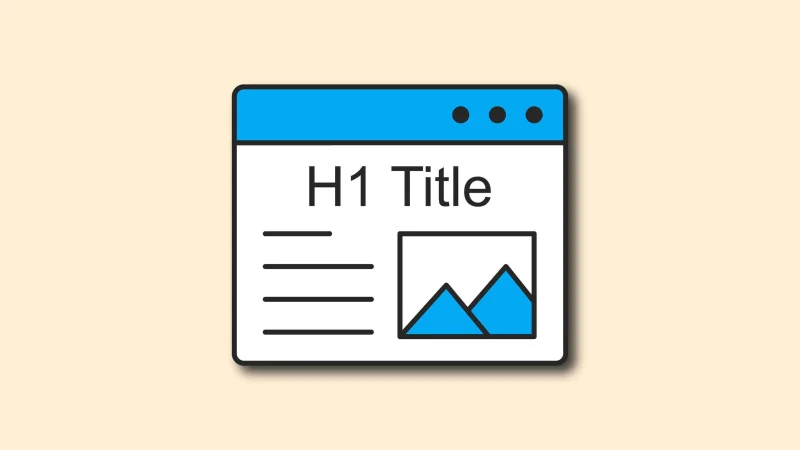H1 tag

The most important tag in your blog or article is the H1 tag. The H1 tag is also called the header tag. This, of course, is because it appears at the top of the article, as a “headline.
Why is the H1 tag actually the most important tag and how do you make it stand out to your visitor and to the search engines? In this blog, we explain all about the H1 tag.
What is the H1 tag?
The H1 tag is a tag that you attach to the title of a text. This is smart to do for your visitor, but also definitely for the search engines.
Within SEO, the rule of thumb is to incorporate the keyword for which you want to rank higher in Google into your title. This way, the search engine sees more clearly what the text is about and links you more quickly to this keyword. This increases your chances of ranking higher in the search engines. (1)

Working together on the H1 tags on your website? Please take a moment to contact me.
How do I select an H1 tag for a landing page?
Choosing an effective H1 tag for landing page SEO requires some deliberate steps. Here is a simple roadmap:
- Understand your target audience: start by understanding your target audience’s information needs and search behavior. This can be done through customer research, analyzing user behavior on your site, and studying industry research.
- Perform keyword analysis: use SEO tools such as Google’s Keyword Planner, SEMRush or Ahrefs to identify relevant keywords that have high search volume and relevance to your topic. Consider long-tail keywords that may be less competitive.
- Choose a focus keyword: based on your keyword analysis, select a focus keyword for your H1 tag. This should be the keyword you want the page to rank for in the search engines.
- Write your H1 tag: write an H1 tag that contains your focus keyword. Try placing the keyword closer to the beginning of the tag. Make sure the H1 tag is also engaging and descriptive, as its purpose is to tell the reader what the page is about and encourage them to read on.
- Keep it short and sweet: ideally, your H1 tag should be between 20 and 70 characters. This makes it easier for search engines to understand and more attractive to users.
- Uniqueness: make sure every page on your website has a unique H1 tag. This helps to avoid confusion for search engines and users.
- Test and measure results: after implementing your H1 tag, monitor its performance. Use Google Analytics and Google Search Console to see how the page is performing in terms of search traffic and ranking.
Remember, despite the importance of H1 tags, SEO is a long and complex process. Other factors such as content quality, backlinks, page speed, and more, also play a big role in how well your page will perform in search results.
WordPress and the H1 tag
The H1 tag is added to a sentence to show the search engines that this is the headline of the text. You do this through the
title
code.Many website owners use WordPress. When you add new text here, you can easily choose the ‘H1’ option and not have to add a piece of code yourself.
The importance of the H1 tag
The H1 tag primarily provides structure to your text. The search engines and visitors see a clear title with the keyword embedded in it. You (often) immediately see what the text is about and give your text a solid structure. This scans easily for the search engines and reads finer for your visitor, so you will rank higher in the search engines.
Read more on this topic
- All about H2 tags and the impact on SEO
- Setting up a silo structure for SEO
- Setting up a website structure for SEO
- SEO landing page setup for Google
- HTML and SEO
The H1 tag and SEO
It is important to include the H1 tag with all your content, if provided with a headline. This way the search engines can clearly scan your text and know what it is about. Only when the headline is properly indexed can you rank higher for the keyword in the search engines. (2)

Working together on the H1 tags on your website? Please take a moment to contact me.
The H1 is also interpreted for SEO as the most important piece of text on a website. Make sure the text within this header is a good reflection of the core of the page.
My advice
So it is important to use a unique H1 tag for each page. If you use the same H1 tags for different pages, Google will not see the difference and they will not be indexed properly.
Make sure keywords are in the title/headline of your text and preferably at the front of the text. However, the latter is not a hard requirement.
Also, when different pages contain the same H1 tag (yes, this still happens) Google gets confused. As a result, Google often does not know which page should rank for the keyword and therefore makes its own choice. This choice, of course, is by no means always the right choice, resulting in the wrong page ranking for the wrong keyword.
Basically, the H1 tag appears only once per page. If the H1 appeared more frequently on a page, Google would have no way of knowing what it was about. Because the H1 tag appears only once on the page, you need to make sure it contains the most important keyword.
- Headings and titles. (s.d.). Google For Developers. https://developers.google.com/style/headings
- Influencing Title Links in Google Search | Google Search Central | Documentation | Google for Developers. (s.d.). Google For Developers. https://developers.google.com/search/docs/appearance/title-link
Frequently Asked Questions
What is an H1 tag?
The H1 Tag is a tag that you include in the title of a given page. Very useful of course for the visitors of the page but even more so for the search engines. This is because in this way it can see that your chosen keyword is incorporated into the title and is more likely to link the page to it.
What is the impact of H1 Tag on SEO?
Provide your page title with the H1 tag, and the search engine can better scan your page. This way, the search engine knows immediately what the text is about and also indexes the title properly. Only if a page’s title can be properly indexed can you achieve better rankings.
Can the wrong H1 tag negatively impact my page?
For a blog or an article, you use different tags. The most important one is the H1 tag, which I call the header tag. This is because it is at the top of an article. It is good to pay extensive attention to this, because search engines and visitors will be looking at this. For SEO, the keyword you want to rank high in Google with should also be incorporated into the title (H1 tag).
In this way, a search engine can easily see what that your text is about and thus it will link to the keyword more quickly. The advantage is that the chances of ranking higher in Google are then also higher. You also need to be vigilant about placing the right information under your H1 tag. If you indicate you provide information on topic A and you suddenly talk about topic B, visitors will not see the added value and will leave on this page.
Also, remember that you only use one H1 tag on your page and it must be unique. If it is too similar to another H1 tag of your website, Google will not be able to index it and thus you will miss an opportunity of findability in the search engines.
Adding an H1 tag gives a text more structure. Visitors and search engines thus see a good title and see the keyword embedded in it. Often they then also know immediately what that particular text is about and whether it is relevant to them (or not). Search engines can also scan the text better this way.
For visitors, this makes the text a lot easier to read. If an H1 tag appears more often on a page, Google cannot index it properly and does not know what it is about. Therefore, it is very confusing if you place an H1 tag on a page more often so my advice is not to do this.
I would rather choose to use H2 tags on your page so that a long text is still clear. So again in a nutshell, use an H1 tag only once per page (a unique tag) and then break up the rest of the text with an H2 tag and, where necessary, an H3 tag under the pieces of text of the H2 tag.
In addition to an H1 tag, you can also use an H2 tag, or an H3 or H4 tag. At the top of an article you’ll often find the H1 tag, then below that come subheads (intermediate headings) and those are often the H2 tags. Then, if you have another important headline that goes with the corresponding H2 tag, you can display that with an H3 tag.
So yes there are other tags you can use. I personally use the H1 tag in my texts at the top, with the main topic (keyword) of this page, i.e. what the article is about. Beneath that will be h2 tags, so I can divide my text into topics. I also pay attention to a clear structure, and I make sure the right information is under each tag.
I think it is important that a reader not be given false hopes or information. Therefore, an H2 tag or other tag should also match the information found below it. You can also build up the text with titles (tags) first and then work out and place the text underneath.
Can I include multiple keywords in an H1 tag?
With content, it is important to add an H1 tag. My advice is to use a unique H1 tag per page. Be careful not to use the same H1 tags for several pages, because then Google will not see any difference and will not index them. In addition, I still recommend placing the keywords at the front of the text as much as possible (when it reads pleasantly).
Some people like to include as many keywords as possible in an H1 tag, but in that case I recommend you create separate articles. You can then create a separate page or text for each important keyword. So you can then create an H1 tag with that particular keyword and break up the most important information in that article with H2 tags.
The point is to keep it organized and, of course, you also want Google to be able to index your page properly. The best way to do this is to start focusing on one keyword in the H1 tag and then you can incorporate synonyms of that particular keyword in the H2 tags.
It is possible that you will use similar H1 tags on multiple pages but is it advisable? No. I advise you not to do that, because Google will not see any difference. As a result, Google may not index a page or index it properly, which is where you miss opportunities.
The advice is to use one H1 tag on the page and then continue working with H2 tags and then you can incorporate synonyms of the keyword in them. Another thing you could do is create several new pages and then focus on one important keyword in each and elaborate on that. This is also good for Google to index and you have more content on your site, which is also an added value.
So you could incorporate similar H1 tags on multiple pages, but remember that they are all unique tags. Google should not see it as “the same thing” because then it will not index the pages. Therefore, pay close attention to this and therefore first check carefully if that you already have a relevant H1 tag on your website, if not then you can use it.






